In the world of French cinema, when it comes to horror the pickings are mighty slim. That may seem difficult to fathom in the wake of the recent Gallic horror movie boom, but French film has throughout the decades been synonymous with refinement and sophistication.
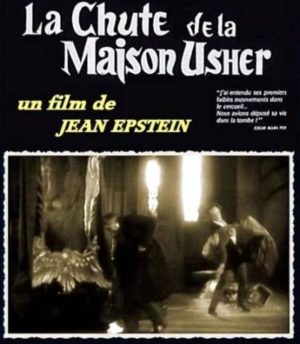 Yet there do exist several worthwhile French horror films, films that are, I feel, essential. I’ll begin this survey with what I believe is the first great French horror film, Jean Epstein’s THE FALL OF THE HOUSE OF USHER (LA CHUTE DE LA MAISON USHER) from 1928. It’s arguably the premiere screen adaptation of Edgar Allen Poe’s classic tale, a richly poetic and suggestive compendium of stunning black-and-white visuals that can be viewed as the true (if unacknowledged) inspiration behind atmospheric genre masterworks like CARNIVAL OF SOULS, LET’S SCARE JESSICA TO DEATH and many of the subsequent films on this list.
Yet there do exist several worthwhile French horror films, films that are, I feel, essential. I’ll begin this survey with what I believe is the first great French horror film, Jean Epstein’s THE FALL OF THE HOUSE OF USHER (LA CHUTE DE LA MAISON USHER) from 1928. It’s arguably the premiere screen adaptation of Edgar Allen Poe’s classic tale, a richly poetic and suggestive compendium of stunning black-and-white visuals that can be viewed as the true (if unacknowledged) inspiration behind atmospheric genre masterworks like CARNIVAL OF SOULS, LET’S SCARE JESSICA TO DEATH and many of the subsequent films on this list.
Skipping over strong but nonessential efforts like THE WOLF OF THE MALVENEURS and THE DEVIL’S HAND (both from 1942), the next logical pick is Georges Franju’s EYES WITHOUT A FACE (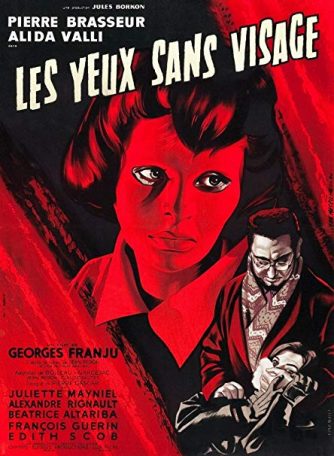 ) from 1960. A magisterial piece of filmmaking that mixes atmosphere and grotesquerie to unforgettable effect, EYES contains several iconic images: the mid-film face lifting sequence remains a benchmark in cinematic nastiness (it reportedly caused mass fainting during the film’s initial theatrical run), while the sight of the faceless heroine wearing a featureless white mask is nearly as striking. If nothing else, this film is unquestionably the first and last word in facial removal.
) from 1960. A magisterial piece of filmmaking that mixes atmosphere and grotesquerie to unforgettable effect, EYES contains several iconic images: the mid-film face lifting sequence remains a benchmark in cinematic nastiness (it reportedly caused mass fainting during the film’s initial theatrical run), while the sight of the faceless heroine wearing a featureless white mask is nearly as striking. If nothing else, this film is unquestionably the first and last word in facial removal.
No listing of French horror cinema is complete without a mention of Jean Rollin, France’s only true horrormeister. Of his 30-plus features I’d choose 1973’s REQUIEM FOR A VAMPIRE (VIERGES ET VAMPIRES) as the standout, though I wouldn’t call it his masterpiece. Truthfully I don’t think there is a masterpiece in 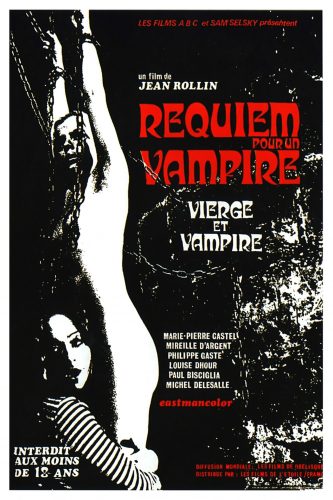 Rollin’s filmography, which consists largely of dramatically inconsistent efforts, all with an abundance of sleazy sex and gore that don’t jibe with the otherwise spare and poetic visuals.
Rollin’s filmography, which consists largely of dramatically inconsistent efforts, all with an abundance of sleazy sex and gore that don’t jibe with the otherwise spare and poetic visuals.
Yet Rollin was a major filmmaker without question, and in REQUIEM he created an enjoyably surreal swirl of eroticism and outrage. The film suffers from Rollin’s usual wobbly storytelling, with a narrative that was literally made up on the spot. It features a pair of sexy clown women chased into a vampire’s castle, where they’re made witness to all sorts of macabre shenanigans. Again, the film isn’t great, but it is an ideal introduction to the themes and preoccupations of one of the genre’s most distinctive talents.
The Polish animator turned feature film director Walerian Borowczyk was, like Jean Rollin, an uncomely gifted filmmaker with a penchant for the macabre and erotic. Also like Rollin, Borowczyk made films that uneasily straddled the line 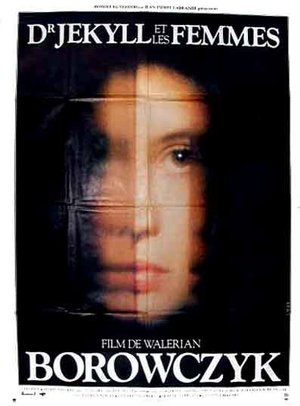 between art and exploitation. Those films are wildly divergent in quality, yet there are a few gems, notably 1981’s French-made DR. JEKYLL ET LES FEMMES (also known as THE STRANGE CASE OF DR. JEKYLL AND MISS OSBOURNE, BLOODBATH OF DR. JEKYLL and BLOODLUST).
between art and exploitation. Those films are wildly divergent in quality, yet there are a few gems, notably 1981’s French-made DR. JEKYLL ET LES FEMMES (also known as THE STRANGE CASE OF DR. JEKYLL AND MISS OSBOURNE, BLOODBATH OF DR. JEKYLL and BLOODLUST).
The film is among the screen’s most idiosyncratic adaptations of Robert Louis Stevenson’s STRANGE CASE OF DR. JEKYLL AND MR. HYDE. It’s the only version I know of that presents the transformation of Dr. Jekyll (Udo Keir) into the evil Mr. Hyde (Gerard Zalcberg) as a scary yet quite pleasurable experience. Borowczyk also gives the character of the doctor’s fiancée (Marina Pierro) a much greater role than in any other version. The choppy editing (an unfortunate Borowczyk trademark) and gratuitous semi-pornographic sleaze (which many prints edit out) are constant irritants, but the gorgeously fetishistic photography and dreamlike atmosphere are superbly calibrated, imparting a sense of erotic delirium that’s like nothing else.
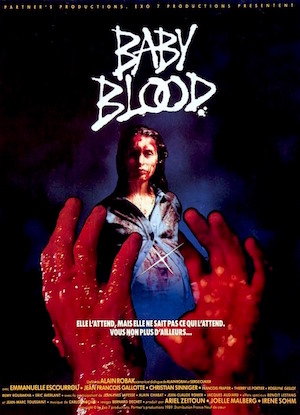 In the 1980s a new kind of horror film appeared in France. Far removed from the tradition of the Fantastique, these new horror films were more influenced by the likes of NIGHT OF THE LIVING DEAD and THE TEXAS CHAINSAW MASSACRE. Examples include MAD MUTILATOR (1983), DEVIL STORY (1985) and writer-director Alain Robak’s BABY BLOOD (1989), a perverse variant on LOOK WHO’S TALKING featuring a pregnant woman (Emmanuelle Escourrou) whose demonic child communicates from her womb.
In the 1980s a new kind of horror film appeared in France. Far removed from the tradition of the Fantastique, these new horror films were more influenced by the likes of NIGHT OF THE LIVING DEAD and THE TEXAS CHAINSAW MASSACRE. Examples include MAD MUTILATOR (1983), DEVIL STORY (1985) and writer-director Alain Robak’s BABY BLOOD (1989), a perverse variant on LOOK WHO’S TALKING featuring a pregnant woman (Emmanuelle Escourrou) whose demonic child communicates from her womb.
All sorts of high-falutin’ ideals have been attributed to Robak’s film, but in truth it works for the very reasons so many seventies-era grindhouse horror films did: it’s fast, darkly funny and unapologetically splat-happy. The early scenes tend to irritate with their annoying physical comedy (fact: NOTHING is more deadly than French slapstick), but once the film hits its stride it’s an irresistibly kinetic joyride, with Escourrou discovering her unborn child loves the red stuff, and finding herself going to truly hellacious limits to obtain it.
The grindhouse aesthetic pioneered by BABY BLOOD and its ilk continued with HIGH TENSION (2003), SHEITAN (2006) and 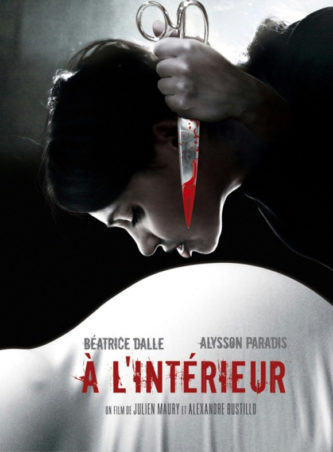 FRONTIER(S) (2007), and culminated in 2007’s amazing INSIDE (A L’INTERIEUR). An ingeniously mounted and profoundly gory suspensor, the film is a far cry from the surreal fantasy of THE FALL OF THE HOUSE OF USHER and EYES WITHOUT A FACE, possessing a verve and attitude all its own. The elegantly simple narrative again centers on pregnancy, with a young pregnant woman (Alysson Paradis) stalked through her home by a psychotic vixen (Beatrice Dalle) who for some reason wants her baby.
FRONTIER(S) (2007), and culminated in 2007’s amazing INSIDE (A L’INTERIEUR). An ingeniously mounted and profoundly gory suspensor, the film is a far cry from the surreal fantasy of THE FALL OF THE HOUSE OF USHER and EYES WITHOUT A FACE, possessing a verve and attitude all its own. The elegantly simple narrative again centers on pregnancy, with a young pregnant woman (Alysson Paradis) stalked through her home by a psychotic vixen (Beatrice Dalle) who for some reason wants her baby.
INSIDE is one of the very few recent films that made me repeatedly jump out of my seat. It remains a standout in shock and suspense that proudly proclaims horror is alive and well in French cinema, while also indicating a new and fascinating direction. Let’s hope future Gallic horror films follow its lead.
